DEAE离子交换层析分离血清蛋白质
二乙氨乙基(Dicthylaminoethyl,DEAE)纤维素层析简介
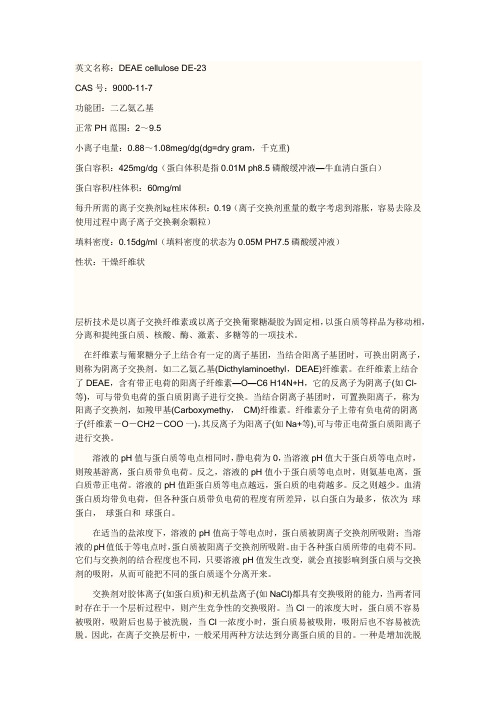
英文名称:DEAE cellulose DE-23CAS号:9000-11-7功能团:二乙氨乙基正常PH范围:2~9.5小离子电量:0.88~1.08meg/dg(dg=dry gram,千克重)蛋白容积:425mg/dg(蛋白体积是指0.01M ph8.5磷酸缓冲液—牛血清白蛋白)蛋白容积/柱体积:60mg/ml每升所需的离子交换剂㎏柱床体积:0.19(离子交换剂重量的数字考虑到溶胀,容易去除及使用过程中离子离子交换剩余颗粒)填料密度:0.15dg/ml(填料密度的状态为0.05M PH7.5磷酸缓冲液)性状:干燥纤维状层析技术是以离子交换纤维素或以离子交换葡聚糖凝胶为固定相,以蛋白质等样品为移动相,分离和提纯蛋白质、核酸、酶、激素、多糖等的一项技术。
在纤维素与葡聚糖分子上结合有一定的离子基团,当结合阳离子基团时,可换出阴离子,则称为阴离子交换剂。
如二乙氨乙基(Dicthylaminoethyl,DEAE)纤维素。
在纤维素上结合了DEAE,含有带正电荷的阳离子纤维素—O—C6 H14N+H,它的反离子为阴离子(如Cl-等),可与带负电荷的蛋白质阴离子进行交换。
当结合阴离子基团时,可置换阳离子,称为阳离子交换剂,如羧甲基(Carboxymethy,CM)纤维素。
纤维素分子上带有负电荷的阴离子(纤维素-O-CH2-COO一),其反离子为阳离子(如Na+等),可与带正电荷蛋白质阳离子进行交换。
溶液的pH值与蛋白质等电点相同时,静电荷为0,当溶液pH值大于蛋白质等电点时,则羧基游离,蛋白质带负电荷。
反之,溶液的pH值小于蛋白质等电点时,则氨基电离,蛋白质带正电荷。
溶液的pH值距蛋白质等电点越远,蛋白质的电荷越多。
反之则越少。
血清蛋白质均带负电荷,但各种蛋白质带负电荷的程度有所差异,以白蛋白为最多,依次为球蛋白,球蛋白和球蛋白。
在适当的盐浓度下,溶液的pH值高于等电点时,蛋白质被阴离子交换剂所吸附;当溶液的pH值低于等电点时,蛋白质被阳离子交换剂所吸附。
离子交换层析实验原理及步骤

离子交换层析实验原理及步骤离子交换层析实验方法阴离子交换剂与阳离子交换剂的装柱和层析过程基本相同。
交联葡聚糖的预处理只需充分溶胀和平衡,不需要除去细粒碎片和酸碱处理。
其他步骤也基本同离子交换纤维素。
1. 剂型的选择根据蛋白质在所用缓冲液pH值下带电荷的种类选择,如pH高于蛋白质等电点,应选阴离子交换剂,反之应选阳离子交换剂。
一般情况下,DEAE-纤维素用于分离酸性蛋白,而CM纤维素用于分离碱性蛋白质。
下面以DEAE-纤维素操作为例,介绍试验方法2. 膨胀活化此步的目的在于除去杂质,暴露DEAE-纤维素上的极性基团。
DEAE-纤维素的用量则根据柱容积的大小和所需过柱样品的量来决定。
一般是1.0g DEAE-纤维素相当于6ml~8ml柱床体积。
表1-4 分离的血清与所需DEAE—纤维素量及其他条件的大致关系血清样品量(ml)DEAE需用量(g)选层析柱规格(cm)选脱液量(ml)1~221×25100~150552×12200~30010102×20300~40020202×37400~800称取所需的量,撒于0.5Mol/L NaOH溶液中(1g DEAE—纤维素干粉约需15倍NaOH液),浸泡1h左右,不时搅拌。
抽滤(以布氏漏斗加两层滤纸或尼龙纱布抽滤),以蒸馏水洗涤,再抽滤,直至滤液近中性为止,再将纤维素浸泡于0.5Mol/L HCl中1h,同样抽滤液至近中性。
再将纤维素浸于0.5Mol/L NaOH液中,同样处理,洗至中性。
3. 平衡将DEAE—纤维素放入0.0lMol/L pH 7. 4 PB液中(即起始缓冲液),静止1h,不时搅拌,待纤维素下沉后,倾去上清液或抽滤除去洗液,如此反复几次至倾出液体的pH值与加入的PB液的pH值相近时为止。
4. 装柱层析柱的选择要大小、长度适当。
一般而言,柱长和柱直径之比为10∶1~20∶1,柱的内径上下要均匀一致。
用前将层析柱在清洁液内浸泡处理24h,然后依次用常水、蒸馏水、起始缓冲液充分洗涤。
DEAE-纤维素离子交换层析纯化血清白蛋白

05 结论与展望
研究结论
DEAE-纤维素离子交换层析是一种有效的血清白蛋白纯化方法,具有高 分辨率和高回收率的特点。
通过优化实验条件,如流速、pH值和离子强度等,可以进一步提高血清 白蛋白的纯度和产量。
DEAE-纤维素离子交换层析纯化血清白蛋白的实验结果证明了该方法的 可行性和实用性,为大规模制备高纯度血清白蛋白提供了新的途径。
5. 洗脱
用不同浓度的NaCl溶液 进行洗脱,收集洗脱液。
6. 检测
用紫外可见分光光度计 和电导仪检测洗脱液中 血清白蛋白的纯度和含
量。
实验步骤
1. 准备实验试剂和仪 器。
3. 将DEAE-纤维素装 入层析柱。
2. 制备DEAE-纤维素 离子交换剂。
实验步骤
4. 用缓冲液平衡层析柱。 5. 将血清白蛋白样品加入层析柱。
实验方法
离子交换层析原理
利用DEAE-纤维素与血清白蛋白 之间的离子相互作用,通过改变 洗脱液的离子强度,将血清白蛋 白与其他杂质分离。
1. 样品处理
将血清白蛋白样品稀释至适当浓 度。
2. 装柱
将DEAE-纤维素装入层析柱中。
实验方法
3. 平衡
用缓冲液平衡层析柱。
4. 上样
将稀释后的血清白蛋白 样品加入层析柱。
分离和纯化核酸
核酸是生物遗传信息的载体,包括DNA和RNA。通过DEAE-纤维素离 子交换层析可以分离和纯化各种核酸,用于研究核酸的结构和功能以及 制备核酸制品。
03 实验材料与方法
实验材料
血清白蛋白样品
缓冲液:Tris-HCl、NaCl 等
DEAE-纤维素离子交换剂
洗脱液:不同浓度的 NaCl溶液
研究目的和意义
8DEAE纤维素离子交换层析纯化血清白蛋白

(3)平衡:装柱后接上恒压贮液瓶,用0.06mol/L
NH4Ac (pH 6.5)洗涤平衡,流速 1ml/min。
2、DEAE—纤维素层析纯化白蛋白
• 1)上样:将4ml 用缓冲液稀释后的血清样品加入上述已平衡 好的层析柱表面,使样品进入柱床内。小心用4ml 0.06mol/L NH4Ac缓冲液洗涤沾在管壁上的蛋白质样品,使其进入床内。
基质
电荷基团 反离子
纤维素-O — CH2— COO-— Na+ 阳离子交换剂
树脂 -O — N+(CH3)2 — OH- 阴离子交换剂
8DEAE纤维素离子交换层析纯 化血清白蛋白
CM- cellulose (Carboxymethyl cellulose)
DEAE- cellulose (diethylaminoethyl cellulose)
8DEAE纤维素离子交换层析纯化血 清白蛋白
• 根据待分离物质带电性质不同的分离纯化方法。 • 以离子交换剂为固定相,特定的离子溶液为流
动相,依据各种离子或离子化合物与离子交换 剂的结合力不同进行分离纯化的层析方式。
离子交换剂
离子交换剂由基质、电荷基团(或称功能基团) 和 反离子组成。基质一般是不溶性聚合物,如 纤维素,交联葡聚糖,交联琼脂糖等;
• DEAE-纤维素离子交换层析(Ion Exchange Chromatography, IEC)纯化 血清白蛋白
8DEAE纤维素离子交换层析纯 化血清白蛋白
1、分离血清得到高纯度的白蛋白
2、掌握DEAE-纤维素离子交换层析原理与 实验操作技术
3、了解紫外检测仪、自动部分收集器、记 录仪、恒压高位槽的原理与使用方法
1-DEAE—层析实验

实验三DEAE—纤维素梯度层析实验1、实验目的与要求:通过DEAE-纤维素阴离子交换剂,采用一条线型离子强度和恒定pH洗提曲线,对鸡蛋白蛋白(CEA)样品进行分级分离,以了解梯度洗提的层析方法。
2、实验原理:DEAE-纤维素是以纤维素为母体接有二乙基氨基乙基(DEAE)活性基团的弱碱性阴离C2H5∣子交换剂(纤维素-O-CH2-CH2-NH )。
它在离子交换层析中可用于蛋白质、核酸、激素、∣C2H5酶等大分子的分离与纯化。
对于某些组分比较复杂或性质比较相近的蛋白质样品。
在采用一般的恒溶剂系统进行离子交换柱层析时,往往不容易分离,这时可采用梯度洗提(装置见图1-2)。
即利用一定的样品离子在不同的离子强度(或pH)溶液中对一定的离子交换剂的平衡常数不同,在洗提过程中,通过不断改变洗提的离子强度(pH不变)[根据实验的具体情况,也可同时改变离子强度和pH],以逐步改变样品中各组分与离子交换剂的交换能力,最后得到分离,这种层析方式即称为梯度洗提层析。
洗提剂的梯度产生如图所示,当A1=A2时,产生线形梯度;当A1>A2时,产生凹型梯度;当A1<A2时,产生凸型梯度(见图1)。
不同的样品,应根据实验情形,选择合适的梯度洗提曲线。
3、实验器材与装置:3-1、实验仪器:(1)、电脑及装置(2)、紫外检测仪(3)、恒流泵(4)、磁力搅拌器(5)、混合器(5)、梯度混合仪(6)、离心机3-2、实验器材:(1)、层析柱(20×1.0cm)(2)、自动取液器(3)、烧杯100 ml(4)、量筒(5)、玻棒3-3、实验装置图(1)、 图1: 梯度洗脱示意图(2)、图2:DEAE —层析实验装置图4、试剂与配制:4-1.实验试剂:(1)、DEAE-52(2)、鸡蛋白蛋白(CEA )(3)、三羧甲基氨基甲烷(Tris)(4)、盐酸(5)、氯化钠4-2.试剂配制:(1)、Buffer A(20mM pH8.0 Tris-HCl )的配制:取Tris g,溶于ml蒸馏水中,用ml HCl调至pH8.0 (2)、Buffer B的配制:Buffer A加1.0M NaCl(3):CEA样液的配制:20.0mg CEA+1ml Buffer A5、方法与步骤:(1)、DEAE-纤维素处理:本实验采用20 mMol/L ,pH8.0 Tris-HCl平衡好的DEAE-纤维素。
血清清蛋白、γ-球蛋白的分离、提纯与鉴定-实验报告

生物化学实验报告姓名:学号:专业年级:组别:生物化学与分子生物学实验教学中心【实验报告第一部分(预习报告内容):①实验原理、②实验材料(包括实验样品、主要试剂、主要仪器与器材)、③实验步骤(包括实验流程、操作步骤和注意事项);评分(满分30分):XX】实验目的:1、掌握盐析法分离蛋白质的原理和基本方法2、掌握凝胶层析法分离蛋白质的原理和基本方法3、掌握离子交换层析法分离蛋白质的原理和基本方法4、掌握醋酸纤维素薄膜电泳法的原理和基本方法5、了解柱层析技术实验原理:1、蛋白质的分离和纯化是研究蛋白质化学及其生物学功能的重要手段。
2、不同蛋白质的分子量、溶解度及等电点等都有所不同。
利用这些性质的差别,可分离纯化各种蛋白质。
3、盐析法:盐析法是在蛋白质溶液中,加入无机盐至一定浓度或达饱和状态,可使蛋白质在水中溶解度降低,从而分离出来。
蛋白质溶液中加入中性盐后,由于中性盐与水分子的亲和力大于蛋白质,致使蛋白质分子周围的水化膜减弱乃至消失。
中性盐加入蛋白质溶液后由于离子强度发生改变,蛋白质表面的电荷大量被中和,更加导致蛋白质溶解度降低,蛋白质分子之间聚集而沉淀。
4、离子交换层析:离子交换层析是指流动相中的离子和固定相上的离子进行可逆的交换,利用化合物的电荷性质及电荷量不同进行分离。
5、醋酸纤维素薄膜电泳原理:血清中各种蛋白质的等电点不同,一般都低于pH7.4。
它们在pH8.6的缓冲液中均解离带负电荷,在电场中向正极移动。
由于血清中各种蛋白质分子大小、形状及所带的电荷量不同,因而在醋酸纤维素薄膜上电泳的速度也不同。
因此可以将它们分离为清蛋白(Albumin)、α1-球蛋白、α2-球蛋白、β-球蛋白、γ-球蛋白5条区带。
实验材料:人混合血清葡聚糖凝胶(G-25)层析柱DEAE纤维离子交换层析柱饱和硫酸铵溶液醋酸铵缓冲溶液 20%磺基水杨酸1%BaCl溶液氨基黑染色液2漂洗液 pH8.6巴比妥缓冲溶液电泳仪、电泳槽实验流程:盐析(粗分离)→葡聚糖凝胶层析(脱盐)→DEAE纤维素离子交换层析(纯化)→醋酸纤维素薄膜电泳(纯度鉴定)实验步骤:(一)盐析+凝胶柱层析除盐:(二)离子交换层析(纯化):(三)醋酸纤维素薄膜电泳:1、点样(如下图):-点样线尽量点得细窄而均匀,宁少勿多2、电泳:①薄膜粗面向下②点样端置阴极端③两端紧贴在滤纸盐桥上,膜应轻轻拉平电压:110V时间:50min3、染色和漂洗:电泳完毕后,关闭电源,将膜取出,直接浸于染色液中5min。
DEAE纤维素离子交换层析法分离血清蛋白

装柱注意事项
• 将处理好的纤维素悬液倾入层析柱内 (注 意不要带入气泡,如混悬液过浓,可增加 适量Na2HPO4液)
• 打开恒流泵,使液体流出,控制流速为3-6 秒1滴。直到全部纤维素都放入柱内(或柱 中纤维素沉积至一定高度)
• 注意:一定不要干柱
22
装柱后期
• 再次检查整套层析设备是否正确连接 • 调好检测零点及流速:以0.01mol/L
生物化学实验
DEAE纤维素离子交换层析法 分离血清蛋白
指导教师:曹文华
1
[实验目的]
1.掌握DEAE-纤维素离子交换层析法 分离血清蛋白质的实验原理及过程。
(参见教材P94-95实验十六)
2.熟悉层析技术的相关原理。 (参见教材P12-23:包括层析技术的概念、分
类及分离原理。离子交换层析法的基本原理、 介质种类、洗脱方式等。整套层析设备的组 成及使用等)
8
离子交换剂:是一类含有可解离基团的不溶性的高 分子化合物。
根据交换剂的结构不同,分为 离子交换树脂
分类 离子交换纤维素 离子交换葡聚糖和离子交换琼脂凝胶
根据交换剂的性能不同,分为 阳离子交换剂 阴离子交换剂
*
9
10
11
本实验分离原理
本实验是用离子交换层析的分离原理,将血 清蛋白质(白蛋白PI=4.88(4.7-4.9); α1球蛋 白PI=α1球蛋白PI = 5.06; β球蛋白PI=5.12; γ球蛋白PI=6.85-7.50 )在pH为8的条件下 交换到装在柱子中的DEAE纤维素离子交换 剂(阴离子交换剂)上后,应用梯度洗脱 法,逐渐改变pH与离子强度,将血清中各 种蛋白质组成成分逐步洗脱下来,从而达 到分离提纯的目的。
Na2HPO4为标准调基线(吸光度A为5%, 透光率T为95%);流速为5-10滴每分钟(612秒1滴)。 • 记录仪:摘下笔帽,笔落下,启动,测量 状态,走纸速度为6cm/h, 量程为100mV
deae纤维素离子交换层析原理

deae纤维素离子交换层析原理DEAE纤维素离子交换层析原理离子交换层析是一种利用离子保持在流动相中的静电相互作用分离混合物的技术。
这种层析技术通常用于对分子进行分离和纯化,是许多分子生物学和生物工艺学实验的关键步骤之一。
DEAE纤维素层析是一种离子交换层析技术,其原理是根据大分子带电荷的相互作用进行分离。
DEAE(二乙氨基乙基)代表了这种离子对相互作用,它们是氨基乙醇与二甲基氨基乙醇的混合物,呈弱碱性。
DEAE纤维素层析分离过程中,混合物被加入含有DEAE纤维素的纯化介质中,通常是由一个固相列和一个移动相组成的。
由于DEAE纤维素有静电吸附性,分子会被吸附到纤维素表面,并与它们的相反电荷互相吸引,形成了一个复杂的矩阵。
随着固相列的流动,分子会以不同的速度被吸附到DEAE纤维素表面,并对带电荷的分子进行分离。
DEAE纤维素层析技术通常用于分离电荷分布不均匀的大分子,例如蛋白质或DNA。
在这种情况下,蛋白质或DNA会在不同程度上与DEAE纤维素相互作用,其中带正电荷的分子会强烈地吸附到DEAE纤维素表面,而带负电荷的分子则会逐渐流过固相列。
DEAE纤维素层析可以用于分离具有不同电荷的蛋白质或DNA分子。
DEAE纤维素层析可用于从复杂混合物中纯化蛋白质甚至核酸。
根据DEAE纤维素层析的原理,我们可以预测分子的行为并更好地优化层析条件。
增加NaCl浓度或者pH值可以瞬间影响DEAE纤维素对分子的亲和力,不同的DEAE纤维素介质或动态增加离子浓度都会影响分子的结合和释放。
DEAE纤维素层析技术非常适合分离带电荷的大分子,因为它利用的是分子之间电荷间的相互作用进行分离。
该技术是分子生物学,生物化学和生物工艺学中广泛使用的分离技术之一,具有广泛的应用前景。
DEAE纤维素层析技术是生化分离技术中最常用的一种技术之一,可以高效地纯化目标大分子,如蛋白质和DNA。
DEAE纤维素层析技术具有操作简单、高分离效率、生物活性好、适用范围广等优点,被广泛应用于制药、食品、环保、农业等领域。
实验7 DEAE—离子交换剂纯化血清IgG

实验7 DEAE—离子交换剂纯化血清IgG(一)原理离子交换是指液相中的离子与固定相上可解离基团的可逆交换反应。
利用这个反应先将要分离的混合物在一定pH的溶液中解离,而后流经固定相,使之与固定相上的可解离基团进行离子交换,吸附于固定相上,凡不能进行交换吸附的成分,则流出层析柱外。
再根据交换吸附于固定相上的各组分解离度的差别,运用不同的pH值或不同盐浓度的溶液作流动相,流过层析柱将各组分分别再交换洗脱下来,这样混合物的各组分即被分开,达到分离的目的,此即为离子交换层析。
离子交换层析中的固定相称为离子交换剂。
它是由在不溶性高分子母体上引入不同的可解离基团所构成。
常用的不溶性高分子母体有纤维素、葡聚糖、琼脂糖及人工合成的树脂等。
引入于母体上的活性基团主要有酸性或碱性物质。
由于引入的酸性物质可解离出H+离子,能与液相中的阳离子交换,故这类离子交换剂称为阳离子交换剂;引入的碱性物质可解离出OH-离子,能与液相中的阴离子交换,故将这类离子交换剂称为阴离子交换剂。
由于引入的酸或碱的强弱不同,两类离子交换剂又分为不同的型。
酸类物质以磺酸基(-SO3H)最强,引入磺酸基的阳离子交换剂称为强酸型;引入磷酸基(-PO3H2)、亚磷酸基(-PO2H)的称中强酸型;引入羧基(-COOH)、酚羟基(-OH)的称为弱酸型。
碱类物质主要是引入胺碱。
引入季胺[ ―N+(CH3)3OH―]基的称为强碱型;引入叔胺[-N(CH3)2 ]、仲胺(-NHCH3)、伯胺(-NH2)基的称为弱碱型。
各型离子交换剂国内外都已定型生产,性能和规格均可查到,本书附录四中列举了一部分。
各型离子交换剂的使用,将由用以分离的物质特性及分离的目的而定。
分离蛋白质(包括酶)常用纤维离子交换剂。
由于蛋白质(酶)的分子量很大,在交换反应后要占有离子交换剂很大的空间位置,不溶性母体空间位置小的交换剂将无法与蛋白质交换容量很低。
纤维素作为不溶性母体是因为纤维素具有亲水性强,容易溶胀;溶胀后具有舒展的长链,表面积大,使大分子特质容易接触并容纳。
生化实验
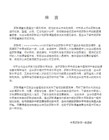
4. 与蛋白质形成R-O-SO3 ….R蛋白质复合物,使蛋白质变性
蛋白酶K(或链霉蛋白酶)
广谱蛋白酶,水解蛋白质。能在SDS和EDTA的存在下保持很高的活性。
酚能有效地使蛋白质变性;
酚不能抑制RNAase的活性;
酚能溶解入10%一15%的水分。
细胞核。
MgCl2: 提供Mg2+,稳定DNA。
NE
NaCL: 50mmol/L
EDTA: 1.二价金属螯合剂,抑制核酸酶;
2.降低细胞膜的稳定性
SDS
1. 溶解膜蛋白和脂肪,从而是细胞膜破裂
2. 溶解核膜和核小体,使其解聚,将核酸释放出来
强度过高样品的滞留作用,可导致样品的拖尾。
电渗:在电场中液体对固体支持物的相对移动。当电渗方向与电泳方向一致时,会加快颗粒泳动速度;反之,当两者方向相反时,会减慢颗粒泳动速度。
分子筛:是凝胶电泳的一个特性。筛孔越小,则颗粒在移动的过程中所受到的阻力也就越大。
12、上样缓冲液中溴酚蓝作用:作为指示剂,因为溴酚蓝呈蓝色,而蛋白质是白色,在SDS-凝胶中不明显,且溴酚蓝的相对分子量比蛋白质(绝大部分)小,电泳时速度比蛋白质稍快,因此当溴酚蓝到达电泳槽底部(可看蓝色调带),则电泳结束。 蔗糖作用:增加样品比重,确保样品沉入样孔内
13、电极缓冲液不能重复使用:蛋白质的活性是受PH和离子浓度影响的,你电泳过一次后缓冲液的离子浓度和PH都改变了,蛋白质的活性肯定会被影响的。
(1)电荷
使它们互相排斥,不易凝集成团
(2)水化膜
使胶粒与水相融、又在胶粒间起隔离作用
盐析原理:破坏蛋白质的两个稳定因素(电荷、水化膜),使蛋白质沉淀
离子交换层析法分离血清蛋白

>单PI纯A >pPHIB梯度洗脱 =P• I溶A液>pPHI值B对蛋白质带电量的影响
操作一
➢膨润 ➢转型
DEAE-纤维素 8g 0.5M HCl 50 ml 混匀后静置30分钟 充分洗涤至 PH≥4
0.5M NaOH 50 ml 混匀后静置30分钟 充分洗涤至 PH≤8
DEAE(二乙基氨基乙基)
+ + + + H
H H H 在H+的攻击下产生SP2杂 化,从而形成带有正电荷
的基团
H+ H+ H+ H+
H+ H+ H+ H+
-
OH
-
OH
-
OH
-
OH
-
OH
-
OH
-
OH
-
OH
-
OH
-
OH
-
OH
-
OH
-
OH
-
OH
-
OH
-
OH
-
OH
-
OH
-
OH
-
OH
-
OH
-
OH
-
OH
-
OH
起始洗脱液,排气、查漏
上口倒入纤维素
已平衡好的纤维素
纤维素沉降完全
纤维素1/2~2/3高度 保留弯月形液体界面
流出管口封闭
操作三 加入样品
加入血清 0.5 ml
待样品完全进入
加入起始洗脱液
洗脱液高约1厘米
层析柱上口旋紧 流出管口封闭
加样前
加样后 样品流入 凝胶
DEAE纤维素离子交换层析法分离血清蛋白
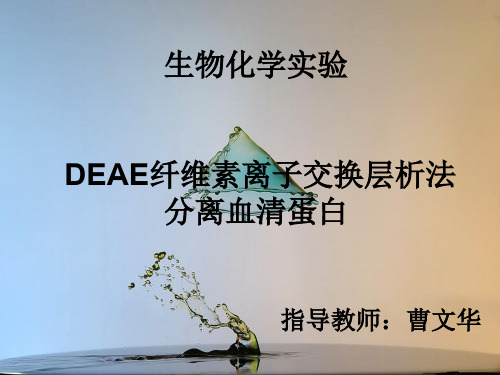
-
OH
-
OH
-
OH
OOHH---
OH -
OH-
OH
-
OH
-
OH
-
OH-
OH -
O-H
OH
-
OH
-
OH
-
OH
-
OH
-
OH
-
OH
-
OH
O-H
OH
OH -
O-H
OH
-
OH
膨润的作用
• 1、使层析介质形成其特定 功能基团
• 2、加大纤维素之间的距离, 以利于蛋白质的通过
• 3、清除杂质
转型或再生的作用
• 1、用置换能力强、浓度高 的离子将层析介质所结合 的离子置换下来
膨润 转型
DEAE-纤维素 6g 0.5M HCl 50 ml 混匀后静置30分钟 充分洗涤至 PH≥4
0.5M NaOH 50 ml 混匀后静置30分钟 充分洗涤至 PH≤8
H+
DEAE(二乙基氨基乙基)
+ + + H H H 在H+的攻击下产生SP2杂 化,从而形成带有正电荷 的基团
H+ H+ H+ H+
实验操作
三、加样
• 当液面接近纤维素顶上界面(注意:一定 不要干柱),关闭恒流泵。用吸量管小心
在层析管内接近纤维素层处缓慢加入血清 0.5mL(注意不要搅拌纤维素界面)。
• 打开恒流泵,使液体缓慢流出(5-10滴/ 分钟),到全部血清刚好流入纤维素层界 面,立即再用滴管小心加入1mL 0.01mol/L Na2HPO4液,直到液面接近纤维素层界面 时,关闭恒流泵。
DEAE离子交换层析分离血清蛋白质
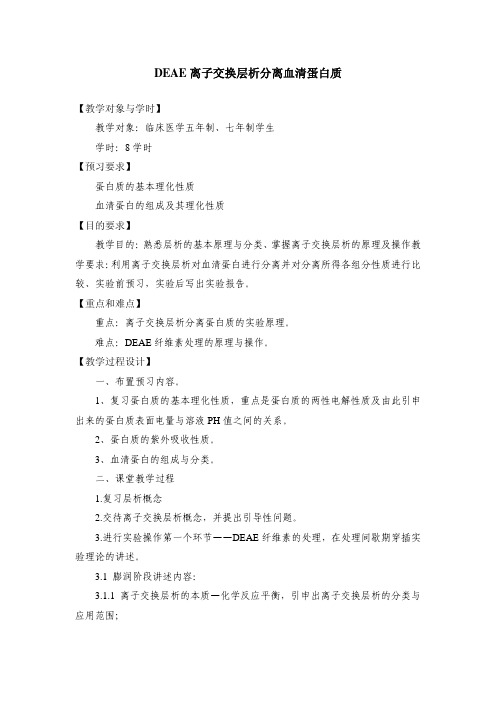
DEAE离子交换层析分离血清蛋白质【教学对象与学时】教学对象:临床医学五年制、七年制学生学时:8学时【预习要求】蛋白质的基本理化性质血清蛋白的组成及其理化性质【目的要求】教学目的:熟悉层析的基本原理与分类、掌握离子交换层析的原理及操作教学要求:利用离子交换层析对血清蛋白进行分离并对分离所得各组分性质进行比较、实验前预习,实验后写出实验报告。
【重点和难点】重点:离子交换层析分离蛋白质的实验原理。
难点:DEAE纤维素处理的原理与操作。
【教学过程设计】一、布置预习内容。
1、复习蛋白质的基本理化性质,重点是蛋白质的两性电解性质及由此引申出来的蛋白质表面电量与溶液PH值之间的关系。
2、蛋白质的紫外吸收性质。
3、血清蛋白的组成与分类。
二、课堂教学过程1.复习层析概念2.交待离子交换层析概念,并提出引导性问题。
3.进行实验操作第一个环节——DEAE纤维素的处理,在处理间歇期穿插实验理论的讲述。
3.1 膨润阶段讲述内容:3.1.1 离子交换层析的本质—化学反应平衡,引申出离子交换层析的分类与应用范围;3.1.2 复习蛋白质表面电量与溶液PH之间的关系,引申出PH值梯度洗脱的意义;3.1.3 讲解双电层理论,引申出离子强度梯度洗脱的意义;3.1.4 离子交换介质处理的理想状态,初步理解交换层析介质处理的要求;3.1.5 待分离蛋白质与交换剂的结合,引申出离子交换层析的分离范围概念。
3.2 转型阶段讲述内容:3.2.1 离子交换层析的分离理论,以及PH值梯度洗脱与离子强度梯度洗脱的不同意义;3.2.2 离子交换剂处理的原理及其对实验结果的影响3.2.3 仪器的连接与使用方法4.平衡阶段进行仪器的调试等上样前的准备5.上样6.梯度洗脱7.中午轮流休息8.实验结果与结果分析【实验报告要点】1.离子交换层析的原理2.实验操作步骤3.实验结果与结果分析【思考题】1.阴阳离子交换剂如何选择?2.离子强度梯度洗脱的意义?3.本实验中,判断依次被洗脱的蛋白质性质差异?【专业英语选读】The molecular details of a biochemical process cannot be fully elucidated until the reacting molecules have been isolated and characterized. Therefore, our understanding of biochemical principles has increased at about the same pace as the development of techniques for the separation and identification of biomolecules. Chromatography has been and will continue to be the most effective technique for isolating and purifying all types of biomolecules. In addition, it is widely used as an analytical tool to measure quantitative properties.A. INTRODUCTION TO CHROMATOGRAPHYAll types of chromatography are based on a very simple principle. The Sample to be examined (called the solute) is allowed to interact with two physically distinct entities-a mobile phase and a stationary phase. The mobile phase, which may be a gas or liquid, moves the sample through a region containing the solid or liquid stationary phase called the sorbent. The stationary phase will not be described in detail at this time, since it varies from one chromatographic method to another. However, it may be considered as having the ability to "bind" some types of solutes. The sample, which may contain one or many molecular components, comes into contact with the stationary phase. The components distribute themselves between the mobile and stationary phases. If some of the sample components are preferentially bound by the stationary phase, they spend more time in the stationary phase and, hence, are retarded in their movement through the chromatography system. Molecules that show weak affinity for the stationary phase spend more time with the mobile phase and are more rapidly removed or eluted from the system. The many interactions that occur between solute molecules and the stationary phase bring about a separation of molecules because of different affinities for the stationary phase. The general process of moving a solute mixture through a chromatographic system is called development.The mobile phase can be collected as a function of time at the end of the chromatographic system. The mobile phase, now called the effluent, contains the solute molecules. If the chromatographic process has been effective, fractions or “cuts” that are collected at different times will contain the different components of the original sample. In summary, molecules are separated because they differ in the extent to which they are distributed between the mobile phase and the stationary phase.Throughout this chapter and others, biochemical techniques will be designated as preparative or analytical, or both. A preparative procedure is one that can be applied to the purification of a relatively large amount of a biological material. The purpose of such an experiment would be to obtain purified material for further characterization and study. Analytical procedures are used most often to determine the purity of a biological sample; however, they may be used to evaluate any physical, chemical, or biological characteristic of a biomolecule or biological system.Partition versus Adsorption ChromatographyChromatographic methods are divided into two types according to how solute molecules bind to or interact with the stationary phase. Partition chromatography is the distribution of a solute between two liquid phases. This may involve direct extraction using two liquids, or it may use a liquid immobilized on a solid support as in the case of paper, thin-layer, and gas-liquid chromatography. For partition chromatography, the stationary phase in Figure consists of inert solid particles coated with liquid adsorbent. The distribution of solutes between the two phases is based primarily on solubility differences. The distribution may be quantified by using the partition coefficient, KD.Adsorption chromatography refers to the use of a stationary phase or support, such as an ion-exchange resin, that has a finite number of relatively specific binding sites for solute molecules. There is not a clear distinction between the processes of partition and adsorption. All chromatographic separations rely, to some extent, on adsorptive processes. However, in some methods (paper, thin-layer, and gas chromatography) these specific adsorptive effects are minimal and the separation is based primarily on nonspecific solubility factors. Adsorption chromatography relies on relatively specific interactions between the solute molecules and binding sites on the surface of the stationary phase. The attractive forces between solute and support may be ionic, hydrogen bonding, or hydrophobic interactions. Binding of solute is, of course, reversible.Because of the different interactions involved in partition and adsorption processes, they may be applied to different separation problems. Partition processes are the most effective for the separation of small molecules, especially those inhomologous series. Partition chromatography has been widely used for the separation and identification of amino acids, carbohydrates, and fatty acids. Adsorption techniques, represented by ion-exchange chromatography, are most effective when applied to the separation of macromolecules including proteins and nucleic acids.In the rest of the chapter, various chromatographic methods will be discussed. You should recognize that no single chromatographic technique relies solely on adsorption or partition effects. Therefore, little emphasis will be placed on a classification of the techniques; instead, theoretical and practical aspects will be discussed.。
DEAE纤维素分离猪血清蛋白
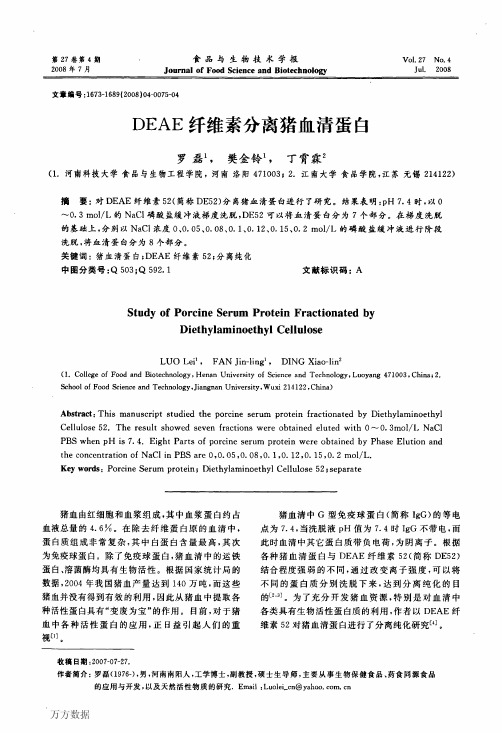
protein
对照IgG和白蛋白标样的电泳结果,结合资料 报道的血清蛋白电泳结果嘲,得到了缓冲液pH 7.4 时,不同盐浓度DE52洗脱下来的蛋白质的组成(见 表1):
78
食品 与 生物技术学报
第27卷
裹1猪血清DE52阶段洗脱NaCI浓度与蛋白质组成的关
系
Tab.1
Relationship between NaCI concentration protein in— gredient of porcine serom phase elution peak by DE52
注:从左到右电泳样品依次为阶段洗脱所得第l、2、3、4,5、6、 7、8吸收蜂和血清。
图3猪血清DE 52阶段洗脱峰电泳图 F喀3 The electrophoresis picture of porcine sernm pro-
tein phase elution peak by DE52
(a)IgG、白蛋白标样电泳分析图
byDE52
中某些蛋白质的带电性质以及与纤维素上带电基 团的结合强度相同或者相近,通过离子交换色谱分 离时就会一起洗脱下来,不能得到有效地分离,如 第3、5、6洗脱所得吸收峰就由多种蛋白质构成(见 图3及图4的3、5、6)。这部分蛋白质可以通过凝 胶过滤或者亲合层析作进一步的分离。
离子交换层析纯化血清蛋白质

一、原理(1)
阴离子交换R-N+(CH3)3Cl- +A-B+
季胺基
阳离子交换R-SO-N+(CH3)3A-+B+ClR-SO-3 B + + A-H +
交换剂的基本类型包括: 树脂\纤维素\葡聚糖 依据被分离样品带电情况而选择阴阳交换剂。
二、器材与试剂
1、器材: 层析柱 移液管 滴管 玻璃棒 烧杯 部分收集器 恒流泵 试管及试管架
滤纸 剪刀及镊子 塑料反应板
2、试剂: (1)0.3M pH6.5醋酸铵缓冲液 (2)0.06M pH6.5醋酸铵缓冲液 (3)0.02M pH6.5醋酸铵缓冲液 (4)200g/L 磺基水杨酸
三、操作
1、装柱:方法同“血清白蛋白盐析及分子筛层 析脱盐”,用0.02M NH4Ac平衡柱子。
2、加样:取2ml血清轻轻加于柱床上,待血清 样品全部进入柱床后,用移液管吸0.02M NH4Ac 溶液约4-5ml加于柱床上。
3、洗脱:连接衡流泵并以1-1.5ml/min的流速 继续用0.02M NH4Ac溶液淋洗,随时监测γ-球蛋 白的流出(约5-6ml液体),并接收,留作电泳 用。
四、现象及解释: 五、结果与讨论:
4、洗脱:收到γ-球蛋白后,继续洗脱30ml, 然后提高盐浓度至0.06M NH4Ac, α-球蛋白 和β-球蛋白可被洗脱下来,收集5-6ml,检 测到蛋白质后继续洗脱30ml。最后,再将盐 浓度提高到0.3M NH4Ac,则白蛋白被洗脱下 来,随时监测蛋白的流出并接收,留作电泳 用。
5、结束:收到白蛋白后继续洗脱10-1 5分即可结束。
一、原理(2)
DEAE纤维素为阴离子交换剂,能吸附带负电荷 的物质,在0.02M pH6.5醋酸铵缓冲液条件下,牛 血清中的白蛋白、α-球蛋白和β-球蛋白均带负电 荷,能被DEAE纤维素吸附。而γ-球蛋白带正电荷 不被吸附而直接流出,此时收集的即为提纯的γ球蛋白。
生物化学实验-DEAE纤维素离子交换层析法分离血清蛋白

实验器材
762分光光度计、梯度发生器、磁 力搅拌器、量筒、漏斗、烧杯、 试管、乳头吸管、移液管、玻璃 棒、尼龙布、螺旋夹。
实验试剂
4、加样 当液面恰好与凝胶面重合时,立即拧紧螺旋夹,用枪向界
面缓慢的加入血清0.2ml,打开柱下口,液体缓慢流出。 当全部血清恰好完全渗到纤维素柱界面时,立即小心地加
0.01mol/L Na2HPO4 缓冲液0.5ml。连上乳胶管胶塞。
平衡液 界面
分离介质
5、洗脱 拧松梯度发生器盛液桶间的螺旋夹。开动磁力搅拌器,(搅
平衡离子是结合于电荷基团上的相反离子,它能与溶 液中其它的离子基团发生可逆的交换反应。平衡离子带正 电的离子交换剂能与带正电的离子基团发生交换作用,称 为阳离子交换剂;平衡离子带负电的离子交换剂与带负电 的离子基团发生交换作用,称为阴离子交换剂。
DEAE纤维素(二乙基氨基乙基,Dicthylaminoethyl,DEAE) 是阴离子交换剂。在pH8.0的溶液中,血清蛋白质都解离成为 阴离子,可交换结合到DEAE纤维素离子交换层析柱上。
空白管)。 以光密度为纵坐标,管号为横坐标,用方格坐标纸绘出血清
蛋白层析谱。观察并判断结果。
注:洗脱开始时先用1个体积的0.01mol/L Na2HPO4起始(100ml)洗脱,然 后再进行梯度洗脱,加样后即开始收集,每管约3ml。
7、作图
• 8、实验结束后,40 ml pH8.0缓冲液清洗, 用pH试纸检测,pH8.0终止。
然后用梯度洗脱法即逐步改变洗脱液的然后用梯度洗脱法即逐步改变洗脱液的phph值与离子强度使值与离子强度使deaedeae纤维素与蛋白质的亲和力降低可使不同蛋白质按其亲纤维素与蛋白质的亲和力降低可使不同蛋白质按其亲和力的大小不同而分步洗脱下来从而达到分离提纯的目的
DEAE_sephadex处理方法
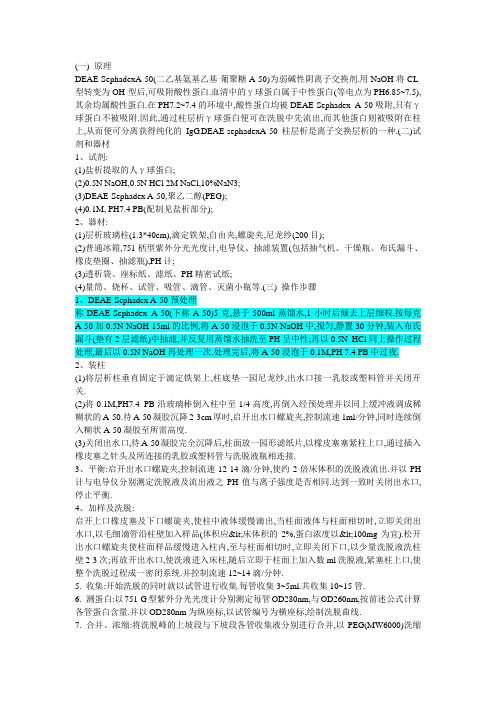
(一) 原理DEAE-SephadexA-50(二乙基氨基乙基-葡聚糖A-50)为弱碱性阴离子交换剂.用NaOH将CL-型转变为OH-型后,可吸附酸性蛋白.血清中的γ球蛋白属于中性蛋白(等电点为PH6.85~7.5),其余均属酸性蛋白.在PH7.2~7.4的环境中,酸性蛋白均被DEAE-Sephadex A-50吸附,只有γ球蛋白不被吸附.因此,通过柱层析γ球蛋白便可在洗脱中先流出,而其他蛋白则被吸附在柱上,从而便可分离获得纯化的IgG.DEAE-sephadexA-50柱层析是离子交换层析的一种.(二)试剂和器材1、试剂:(1)盐析提取的人γ球蛋白;(2)0.5N NaOH,0.5N HCl 2M NaCl,10%NaN3;(3)DEAE-Sephadex A-50,聚乙二醇(PEG);(4)0.1M, PH7.4 PB(配制见盐析部分);2、器材:(1)层析玻璃柱(1.3*40cm),滴定铁架,自由夹,螺旋夹,尼龙纱(200目);(2)普通冰箱,751桮型紫外分光光度计,电导仪、抽滤装置(包括抽气机、干燥瓶、布氏漏斗、橡皮垫圈、抽滤瓶),PH计;(3)透析袋、座标纸、滤纸、PH精密试纸;(4)量筒、烧杯、试管、吸管、滴管、灭菌小瓶等.(三) 操作步骤1、DEAE-Sephadex A-50预处理称DEAE-Sephadex A-50(下称A-50)5克,悬于500ml蒸馏水,1小时后倾去上层细粒.按每克A-50加0.5N NaOH 15ml的比例,将A-50浸泡于0.5N NaOH中,搅匀,静置30分钟,装入布氏漏斗(垫有2层滤纸)中抽滤,并反复用蒸馏水抽洗至PH呈中性;再以0.5N HCl同上操作过程处理,最后以0.5N NaOH再处理一次.处理完后,将A-50浸泡于0.1M,PH 7.4 PB中过夜.2、装柱(1)将层析柱垂直固定于滴定铁架上,柱底垫一园尼龙纱,出水口接一乳胶或塑料管并关闭开关.(2)将0.1M,PH7.4 PB沿玻璃棒倒入柱中至1/4高度,再倒入经预处理并以同上缓冲液调成稀糊状的A-50.待A-50凝胶沉降2-3cm厚时,启开出水口螺旋夹,控制流速1ml/分钟,同时连续倒入糊状A-50凝胶至所需高度.(3)关闭出水口,待A-50凝胶完全沉降后,柱面放一园形滤纸片,以橡皮塞塞紧柱上口,通过插入橡皮塞之针头及所连接的乳胶或塑料管与洗脱液瓶相连接.3、平衡:启开出水口螺旋夹,控制流速12-14滴/分钟,使约2倍床体积的洗脱液流出.并以PH 计与电导仪分别测定洗脱液及流出液之PH值与离子强度是否相同.达到一致时关闭出水口,停止平衡.4、加样及洗脱:启开上口橡皮塞及下口螺旋夹,使柱中液体缓慢滴出,当柱面液体与柱面相切时,立即关闭出水口,以毛细滴管沿柱壁加入样品(体积应<床体积的2%,蛋白浓度以<100mg为宜).松开出水口螺旋夹使柱面样品缓慢进入柱内,至与柱面相切时,立即关闭下口,以少量洗脱液洗柱壁2-3次;再放开出水口,使洗液进入床柱,随后立即于柱面上加入数ml洗脱液,紧塞柱上口,使整个洗脱过程成一密闭系统.并控制流速12~14滴/分钟.5. 收集:开始洗脱的同时就以试管进行收集.每管收集3~5ml.共收集10~15管.6. 测蛋白:以751-G型紫外分光光度计分别测定每管OD280nm,与OD260nm,按前述公式计算各管蛋白含量.并以OD280nm为纵座标,以试管编号为横座标,绘制洗脱曲线.7. 合并、浓缩:将洗脱峰的上坡段与下坡段各管收集液分别进行合并,以PEG(MW6000)洗缩至所需体积,加入0.02%NaN3防腐剂,于4℃保存备用.8. A-50凝胶的再生:在柱上先以2M NaCl洗柱上的杂蛋白至流出液的OD280nm<0.02,再以蒸馏水洗去柱中盐.然后按预处理过程将A-50再处理一遍即达再生.近期用时泡于洗脱缓冲液中4℃保存;近期不用时,以无水酒精洗2次,再置50℃温箱烘干,装瓶内保存.(四) 注意事项1. 柱的选择:从理论上说,只要柱足够长,就得获得理想的分辨率,但由于层析柱流速同压力梯度有关,柱长增加使流速减慢,峰变宽,分辨率降低.柱的直径增加,使液体流动的不均匀性增加,分辨率明显下降.2. 纯化过程必须严格控制脱缓冲液的PH及离子强度.样品与A-50凝胶必须用洗脱缓冲液彻底平衡后,才能进行柱层析.3. 所装的柱床必须表面平整,无沟流及气泡,否则应重装.4. 洗脱过程中应严格控制流速,且勿过快.5. 上样的体积要小,浓度不宜过高.6. 加样及整个洗脱过程中,严防柱面变干.。
- 1、下载文档前请自行甄别文档内容的完整性,平台不提供额外的编辑、内容补充、找答案等附加服务。
- 2、"仅部分预览"的文档,不可在线预览部分如存在完整性等问题,可反馈申请退款(可完整预览的文档不适用该条件!)。
- 3、如文档侵犯您的权益,请联系客服反馈,我们会尽快为您处理(人工客服工作时间:9:00-18:30)。
DEAE离子交换层析分离血清蛋白质【教学对象与学时】教学对象:临床医学五年制、七年制学生学时:8学时【预习要求】蛋白质的基本理化性质血清蛋白的组成及其理化性质【目的要求】教学目的:熟悉层析的基本原理与分类、掌握离子交换层析的原理及操作教学要求:利用离子交换层析对血清蛋白进行分离并对分离所得各组分性质进行比较、实验前预习,实验后写出实验报告。
【重点和难点】重点:离子交换层析分离蛋白质的实验原理。
难点:DEAE纤维素处理的原理与操作。
【教学过程设计】一、布置预习内容。
1、复习蛋白质的基本理化性质,重点是蛋白质的两性电解性质及由此引申出来的蛋白质表面电量与溶液PH值之间的关系。
2、蛋白质的紫外吸收性质。
3、血清蛋白的组成与分类。
二、课堂教学过程1.复习层析概念2.交待离子交换层析概念,并提出引导性问题。
3.进行实验操作第一个环节——DEAE纤维素的处理,在处理间歇期穿插实验理论的讲述。
3.1 膨润阶段讲述内容:3.1.1 离子交换层析的本质—化学反应平衡,引申出离子交换层析的分类与应用范围;3.1.2 复习蛋白质表面电量与溶液PH之间的关系,引申出PH值梯度洗脱的意义;3.1.3 讲解双电层理论,引申出离子强度梯度洗脱的意义;3.1.4 离子交换介质处理的理想状态,初步理解交换层析介质处理的要求;3.1.5 待分离蛋白质与交换剂的结合,引申出离子交换层析的分离范围概念。
3.2 转型阶段讲述内容:3.2.1 离子交换层析的分离理论,以及PH值梯度洗脱与离子强度梯度洗脱的不同意义;3.2.2 离子交换剂处理的原理及其对实验结果的影响3.2.3 仪器的连接与使用方法4.平衡阶段进行仪器的调试等上样前的准备5.上样6.梯度洗脱7.中午轮流休息8.实验结果与结果分析【实验报告要点】1.离子交换层析的原理2.实验操作步骤3.实验结果与结果分析【思考题】1.阴阳离子交换剂如何选择?2.离子强度梯度洗脱的意义?3.本实验中,判断依次被洗脱的蛋白质性质差异?【专业英语选读】The molecular details of a biochemical process cannot be fully elucidated until the reacting molecules have been isolated and characterized. Therefore, our understanding of biochemical principles has increased at about the same pace as the development of techniques for the separation and identification of biomolecules. Chromatography has been and will continue to be the most effective technique for isolating and purifying all types of biomolecules. In addition, it is widely used as an analytical tool to measure quantitative properties.A. INTRODUCTION TO CHROMATOGRAPHYAll types of chromatography are based on a very simple principle. The Sample to be examined (called the solute) is allowed to interact with two physically distinct entities-a mobile phase and a stationary phase. The mobile phase, which may be a gas or liquid, moves the sample through a region containing the solid or liquid stationary phase called the sorbent. The stationary phase will not be described in detail at this time, since it varies from one chromatographic method to another. However, it may be considered as having the ability to "bind" some types of solutes. The sample, which may contain one or many molecular components, comes into contact with the stationary phase. The components distribute themselves between the mobile and stationary phases. If some of the sample components are preferentially bound by the stationary phase, they spend more time in the stationary phase and, hence, are retarded in their movement through the chromatography system. Molecules that show weak affinity for the stationary phase spend more time with the mobile phase and are more rapidly removed or eluted from the system. The many interactions that occur between solute molecules and the stationary phase bring about a separation of molecules because of different affinities for the stationary phase. The general process of moving a solute mixture through a chromatographic system is called development.The mobile phase can be collected as a function of time at the end of the chromatographic system. The mobile phase, now called the effluent, contains the solute molecules. If the chromatographic process has been effective, fractions or “cuts” that are collected at different times will contain the different components of the original sample. In summary, molecules are separated because they differ in the extent to which they are distributed between the mobile phase and the stationary phase.Throughout this chapter and others, biochemical techniques will be designated as preparative or analytical, or both. A preparative procedure is one that can be applied to the purification of a relatively large amount of a biological material. The purpose of such an experiment would be to obtain purified material for further characterization and study. Analytical procedures are used most often to determine the purity of a biological sample; however, they may be used to evaluate any physical, chemical, or biological characteristic of a biomolecule or biological system.Partition versus Adsorption ChromatographyChromatographic methods are divided into two types according to how solute molecules bind to or interact with the stationary phase. Partition chromatography is the distribution of a solute between two liquid phases. This may involve direct extraction using two liquids, or it may use a liquid immobilized on a solid support as in the case of paper, thin-layer, and gas-liquid chromatography. For partition chromatography, the stationary phase in Figure consists of inert solid particles coated with liquid adsorbent. The distribution of solutes between the two phases is based primarily on solubility differences. The distribution may be quantified by using the partition coefficient, KD.Adsorption chromatography refers to the use of a stationary phase or support, such as an ion-exchange resin, that has a finite number of relatively specific binding sites for solute molecules. There is not a clear distinction between the processes of partition and adsorption. All chromatographic separations rely, to some extent, on adsorptive processes. However, in some methods (paper, thin-layer, and gas chromatography) these specific adsorptive effects are minimal and the separation is based primarily on nonspecific solubility factors. Adsorption chromatography relies on relatively specific interactions between the solute molecules and binding sites on the surface of the stationary phase. The attractive forces between solute and support may be ionic, hydrogen bonding, or hydrophobic interactions. Binding of solute is, of course, reversible.Because of the different interactions involved in partition and adsorption processes, they may be applied to different separation problems. Partition processes are the most effective for the separation of small molecules, especially those inhomologous series. Partition chromatography has been widely used for the separation and identification of amino acids, carbohydrates, and fatty acids. Adsorption techniques, represented by ion-exchange chromatography, are most effective when applied to the separation of macromolecules including proteins and nucleic acids.In the rest of the chapter, various chromatographic methods will be discussed. You should recognize that no single chromatographic technique relies solely on adsorption or partition effects. Therefore, little emphasis will be placed on a classification of the techniques; instead, theoretical and practical aspects will be discussed.。
